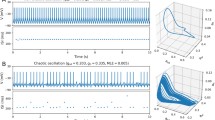Abstract
In this paper, the dynamics of a map-based model is proposed firstly. It is a simple model which can not only reproduce rich behaviors of biological neurons but also compute efficiently. Then, the dynamics of two coupled maps that model the behavior of two electrically coupled neurons is discussed. By tuning the coupling strength, synchronization of two spiking or bursting neurons are simulated. Furthermore, the spatiotemporal behavior of a small-world neuronal network using map-based model is studied. Detailed investigations reveal that the collective dynamics of neuronal activity will be affected by varying some key parameters, such as the coupling strength of neurons, connection probability and the number of nearest neighbor in small-world topology. Our study suggests that the map-based model will give us a new opportunity to reproduce the real biological network containing a large number of neurons.











Similar content being viewed by others
References
Rulkov NF (2002) Modeling of spiking-bursting neural behavior using two-dimensional map. Phys Rev E 65:041922
Izhikevich EM (2004a) Spike-timing dynamics of neuronal groups. Cereb Cortex 14(8):933–944
Hodgkin AL, Huxley AF (1952) A qualitative description of membrane current and its application to conduction and excitation in nerve. J Physiol 117:500–544
Knight BW (1972) Dynamics of encoding in a population of neurons. J Gen Physiol 59:734C766
Stein RB (1967) Some models of neuronal variability. Biophys J 7(1):37–68
Izhikevich EM (2003) Simple model of spiking neurons. IEEE Trans Neural Netw 14(6):1569–1572
FitzHugh R (1961) Impulses and physiological states in theoretical models of nerve membrane. Biophys J 1(6):445–466
Rose RM, Hindmarsh JL (1989) The assembly of ionic currents in a thalamic neuron. I. The three-dimensional model. Proc R Soc Lond B 237:267–288
Morris C, Lecar H (1981) Voltage oscillations in the barnacle giant muscle fiber. Biophys J 35:193–213
Bazhenov M, Timofeev I, Steriade M, Sejnowski TJ (2002) Model of thalamocortical slow-wave sleep oscillations and transitions to activated states. J Neurosci 22:8691–8704
Houweling AR, Bazhenov M, Timofeev I, Grenier F, Steriade M, Sejnowski TJ (2002) Frequency- selective augmenting responses by short-term synaptic depression in cat neocortex. J Physiol 542:599C617
Destexhe A, Bal T, McCormick DA, Sejnowski TJ (1996) Ionic mechanisms underlying synchronized and propagating waves in a model of ferret thalamic slices. J Neurophysiol 76:2049C2070
Golomb D, Wang XJ, Rinzel J (1996) Propagation of spindle waves in a thalamic slice model. J Neurophysiol 75:750C769
Traub RD, Jefferys JG, Whittington MA (1997) Simulation of gamma rhythms in networks of interneu- rons and pyramidal cells. J Comput Neurosci 4:141–150
Bazhenov M, Stopfer M, Rabinovich M, Huerta R, Abarbanel HD, Sejnowski TJ, Laurent G (2001) Model of transient oscillatory synchronization in the locust antennal lobe. Neuron 30:553C567
Rulkov NF, Timofeev I, Bazhenov M (2004) Oscillations in large-scale cortical networks: map-based model. J Comput Neurosci 17:203–223
Sausedo JM, Pisarchik AN (2014) Synchronization of map-based neurons with memory and synaptic delay. Physi Lett A 378(30):2108–2112
Rulkov NF, Bazhenov M (2008) Oscillations in large-scale cortical network models. J Biol Phys 34:279–299
Cao HJ, Wu YG (2013) Bursting types and stable domains of Rulkov neuron network with mean field computing. Int J Bifurc Chaos 23(12):1330041–1330061
Wang Q, Chen G, Perc M (2011) Synchronous bursts on scale-free neuronal networks with attractive and repulsive coupling. PLoS One 6(1):el5851
Heagy JF, Carroll TL, Pecora LM (1994) Synchronous chaos in coupled oscillator systems. Phys Rev E 50(3):1874–1885
Qu JY, Wang RB, Du Y (2012) Synchronization study in ring-like and grid-like neuronal networks. Cogn Neurodyn 6(1):21–31
Wu CW, Chua LO (1995) Synchronization in an array of linearly coupled dynamical systems. IEEE Trans Circuits Syst I 42(8):430–447
Gade PM (1996) Synchronization of oscillators with random nonlocal connectivity. Phys Rev E 54:64–70
Manrubia SC, Mikhailov SM (1999) Synchronization and clustering in randomly coupled chaotic dynamical networks. Phys Rev E 60:1579–1589
Qu JY, Wang RB, Yan CK, Du Y (2014) Oscillations and synchrony in a cortical neural network. Cogn Neurodyn 8(2):157–166
Watts DJ, Strogatz SH (1998) Collective dynamics of ‘small world’ networks. Nature 393:440–442
Bassett DS, Bullmore E (2006) Small-world brain networks. Neuroscientist 12(6):512–523
Sun WG, Wang RB, Wang WX, Cao JT (2010) Analyzing inner and outer synchronization between two coupled discrete-time networks with time delays. Cogn Neurodyn 4(3):225C231
Volman V, Baruchi I, Ben-Jacob E (2005) Manifestation of function-follow-form in cultured neuronal networks. Phys Biol 2(2):98–110
Yu S, Huang DB, Singer W et al (2008) A small world of neuronal synchrony. Cereb Cortex 18(2):2891–2901
Roxin A, Riecke H, Solla SA (2004) Self-sustained activity in a small-world network of excitable neurons. Phys Rev Lett 92:198101
Kwon O, Moon HT (2002) Coherence resonance in small-world networks of excitable cell. Phys Lett A 298:319–324
Gong YB, Xu B, Xu Q, Yang CL, Ren TQ, Hou ZH, Xin HW (2006) Ordering spatiotemporal chaos in complex thermosensitive neuron networks. Phys Rev E 73:046137
Wei DQ, Luo XS (2007) Ordering spatiotemporal chaos in discrete neural networks with small-world connections. Europhys Lett 78:68004
Wang M, Hou Z, Xin H (2006) Ordering spatiotemporal chaos in small-world neuron networks. Chem Phys Chem 7:579–582
Perc M (2007) Stochastic resonance on excitable small-world networks via a pacemaker. Phys Rev E 76:066203
Perc M, Gosak M (2008) Pacemaker-driven stochastic resonance on diffusive and complex networks of bistable oscillators. New J Phys 10:053008
Hasegawa H (2005) Synchronizations in small-world networks of spiking neurons: diffusive versus sigmoid couplings. Phys Rev E 72:056139
Protopapas AD, Vanier M, Bower JM (1998) Simulating of lagre networks of neurons. In: Koch Ch, Segev I (eds) Methods in neuronal modeling: from ions to networks. MIT, Cambridge, p 461
Acknowledgments
The work is supported by National Natural Science Foundation of China (11402294,11232005) and Zhejiang Provincial Natural Science Foundation (Q14A020013).
Author information
Authors and Affiliations
Corresponding author
Ethics declarations
Conflict of interest
The authors declare that they have no conflict of interest.
Rights and permissions
About this article
Cite this article
Qu, J., Wang, R., Yan, C. et al. Spatiotemporal Behavior of Small-World Neuronal Networks Using a Map-Based Model. Neural Process Lett 45, 689–701 (2017). https://doi.org/10.1007/s11063-016-9547-5
Published:
Issue Date:
DOI: https://doi.org/10.1007/s11063-016-9547-5




